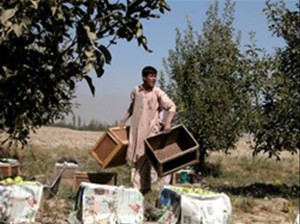Home » Reports & Data » Progress » Transforming Lives » New Irrigation Technology Gives Families Hope

The 20-year-old son of Habiabdul Habib, owner of the 10,000-tree Paghman orchard, loads wooden crates full with apples. After successive years of drought, the family experienced tremendous success in 2003. Their income rose by $15,629. The apricot crop in
Matt Herrick
USAID helps Afghan family survive drought and expand their orchard business
1 DECEMBER 2003 | PAGHMAN
Sixty-four-year-old Habiabdul Habib and his family returned to their home in Paghman from Pakistan five years ago after spending twelve years living as refugees while their home was destroyed by Taliban and Northern Alliance fighters. But when they returned home to Afghanistan they met another foe: drought.
Despite heavy winter snow and increased rainfall from 2002 -2003, Paghman continues to suffer from a water shortage. Accessing water for drinking, cooking and irrigating land was challenging.
"We have a well, but the pumping everyday is too much," Habib says, beginning to catalog the past disappointments one after another. "The canals in the village deliver water only one or two months each year. And you must pump from down there. The clay in the dirt clogs the pumps. Our pumps break."
Habib, owner of a five-hectare orchard, found it difficult to provide for his 24 member family — all living together under one roof. He learned about a new irrigation system when USAID sponsored a community outreach program to educate those in need. Funded through a quick impact initiative, the project targeted farmers who grow and sell a majority of their crops to the market, or commercially.
The activity helped 22 commercial farming families on five farms. An irrigation specialist, sponsored by USAID, first trained and then helped the farmers plan and implement the system. The specialist also trained USAID’s local partners and distributed start-up supplies like hoses, filters, valves, and drippers. Overall, the project has increased available water by two-to-three times the initial amounts.
Based on the drip irrigation technology that relies mainly on gravity, a conservative water supply, and clear pathways of delivery, Habib’s system is the largest-scale drip project in the area funded through USAID. Rather than pumping water from the well into the irrigation furrows and hoping for enough water to flood the orchard, the farmer now pumps directly into the holding tank.
After successive years of drought, the family experienced tremendous success in 2003. Their income rose by $15,629. The apricot crop increased by 16,880 kg.
The holding tank and diesel pumps were Habib’s contribution to the project in cost and labor. He and his sons re-dug and reinforced an old well to squeeze a few more meters from the water table — and the results have paid handsomely.
Habib’s 20-year-old son loads wooden crates full of green and red apples. Apricots, peaches, almonds, mulberry, and plums grow in different sections. The orchard mule is packed with two crates at a time and has made at least four trips in one hour to the family’s home.
"Without the system, this would all be dry," explains Habib as he points to his orchard. "And we would have nothing."







Comment
Make a general inquiry or suggest an improvement.